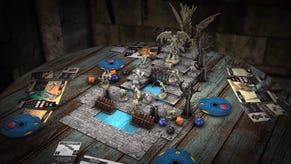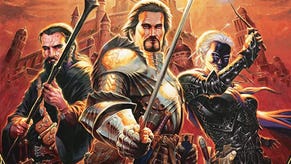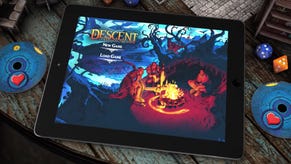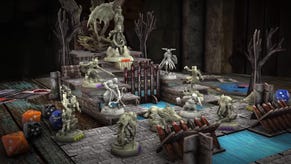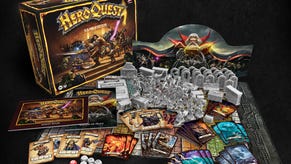Descent: Legends of the Dark board game review - is the £175 dungeon-crawler worth it after finishing its 35-hour campaign?
Rune with a view.
In every sense of the word, Descent: Legends of the Dark is the biggest board game release of the summer. The successor-not-sequel to Fantasy Flight Games’ beloved dungeon-crawler Descent: Journeys in the Dark, Legends of the Dark has nearly a decade’s worth of expectation and hype riding on its shoulders. Luckily, they’re broad shoulders, encased in a dense cardboard cube roughly the size of a small footstool that costs a take-a-seat-for-a-moment $175/£175.
Let’s address the pixelated elephant in the room, and the biggest reason why Legends of the Dark isn’t Journeys in the Dark: Third Edition. In addition to its well-stocked box of plastic and cardboard toys, you’ll need a free companion app to play, replacing the human DM-like overlord of Descents past. (Journeys was eventually granted an optional companion app, Road to Legend, that introduced an AI opponent, but Legends’ hybrid approach is baked in as absolutely mandatory.)
If you’re already convinced that pixels and paper shouldn’t mix, this won’t be the game to convince you otherwise. In fact, Legends of the Dark has the deepest app integration of almost any board game I’ve played. The good news is that it’s a quality experience on both table and screen. For the most part, anyway. Having now spent over 40 hours with the game and seen its campaign to conclusion, I’ve found myself appreciating its ambition and boldness, while also hitting moments of severe frustration and disappointment at its flaws.
On the table, Legends of the Dark is an astonishing presence. The main reason for that awkwardly-proportioned, Kallax-filling cube which - surprise! - arrives half-empty? It’s to store a table’s worth of 3D terrain, which you’ll spend your first couple of hours building like a Lego set for fans of trees, stone pillars and bookshelves. Cardboard terrain may seem like a simple addition but, as anyone who remembers the days of classic dungeon-crawler HeroQuest will know, that third dimension goes a long way in conjuring up Descent’s fantasy world of Terrinoth and its varied dungeons, forests and settlements.
Legends of the Dark boasts some of the most impressive level design any modern dungeon-crawler has to offer.
Dotting some trees around is one thing, but Legends of the Dark’s visual panache kicks into overdrive the first time it asks you to take some of those pillars and suspend a map tile above the table. The game’s creators use the terrain to spellbinding effect, creating multiple layers of verticality in the environments that couples with some of the most impressive level design any modern dungeon-crawler has to offer. Characters can find themselves suddenly falling between levels, climbing the circling stairs of a tower that actually ascends from the tabletop, outrunning crumbling architecture - which vanishes off the table with each passing round - and clambering up objects to access new areas, sometimes all in the space of a single scenario.

The terrain couples with the companion app to offer an experience that comes closer to a tabletop RPG than a typical board game in terms of players’ ability to interact with the world. Almost every 3D object can be interacted with on-screen, often with a variety of options - will you climb the tree to scout ahead, use its branches to reach a new level, pick its fruit to regain health or simply forage some materials for later on? In these moments, the benefit of having a companion app operate as a digital dungeon master is obvious - handling so many dynamic interactions using just cards or tables in a book would be overwhelming.
The box’s handy storage and app’s step-by-step approach even manages to keep the time spent slotting together each map to a minimum, with new areas revealed as the players explore rather than requiring an upfront building session. It’s seriously slick, and testament to the careful balance struck between physical impact and digital convenience.

Flashy presentation would mean little without a decent game attached. Fortunately, Legends of the Dark has fun gameplay in spades, spread across a campaign that took us somewhere between 35 and 40 hours to finish in full with two players - including the main story missions and all available side quests, each of which typically lasted between one and two hours. The relatively consistent length of each scenario makes Legends of the Dark feel like the ideal game for a group looking for a weekly roleplaying adventure, without the admin of planning a session or having to nominate a GM.
Legends of the Dark has fun gameplay in spades, spread across a campaign that took us somewhere between 35 and 40 hours to finish.
The surface of the game is nuts-and-bolts dungeon-crawling; players spend their turns moving their characters around each grid-board map and performing two actions, rolling dice to calculate everything from attacking enemies to picking a lock on a treasure chest. (Skill checks are always two six-sided dice, while combat and defence ranges from a d6 to d12 depending on the character’s ability.) Alone, that would be enough to fill an hour or two - but not quite enough to justify dozens of hours and that price tag, or make Descent any different to the hundreds of samey dungeon-crawlers clad in different RPG-lite cosplay.
Fortunately, it’s not alone. Descent’s familiar dice-chucking fare combines with an engaging use of double-sided cards for weapons, skills and the character themselves, allowing players to flip cards to clear negative conditions such as poison, fatigue tokens gained by performing more powerful abilities, and access alternative effects and options on the reverse of each card. Other conditions inflict damage for flipping cards, leading to mid-game dilemmas about how to create the best combo for smashing enemies/dodging traps/reaching treasure without taking too much damage or spending too many of your precious actions preparing.

Like the terrain, having every card offer a different benefit is a simple addition that adds another crucial dimension. There’s plenty of room to experiment and play around with skills, all without dragging turns down into checking complex rules or long moments of umm-ing and err-ing. Allowing fatigue tokens to build up, rather than be a limited resource collected and spent, means players are able to pop off special moves on a regular basis. You’ll never need to spend turn after turn chipping away with basic attacks because your one ultra-ability whiffed. With rare exception, turns in Legends of the Dark always feel meaningful and fresh - there’s always something to interact with, an ability to experiment with or somewhere new to explore.
You’ll want to experiment and explore for the whole of those 35-plus hours, too. Having long been completely unphased by publisher Fantasy Flight Games’ repeated attempts to turn Descent’s world of Terrinoth into more than Yet Another Forgettable Fantasy Setting, Legends of the Dark has finally succeeded in getting me to invest in and care about its lore.
That's largely thanks to Legends of the Dark’s would-be Fellowship of party members, who offer both varied gameplay - sneaky cat-person Chance, who flips his character card to disappear back into the shadows before another stealthy strike, is a particular highlight - and engaging character development as their backstories are fleshed out. I found myself invested in paladin Brynn’s familial drama, Chance’s escape from a life of crime and Vaerix’s strive for independence as a dragon-hybrid, to name a few examples, all of which provide greater stakes to scenarios driven by focused character development rather than more hacking-and-slashing. The playable characters also mark a much-needed step forward from the tired tropes of classic cis-white-male-dominated fantasy, including a non-binary character, a deaf character who communicates with sign language (which forms the gentle basis of a particularly memorable scene) and multiple people of colour.
The wider story (this game is billed as Act I in a planned series) revolves around familiar fantasy staples: magical MacGuffins, kingdoms in peril and something about the end of the world. It’s effective rather than exhausting for the most part, but highlights the characters as the real draw.

The bulk of the narrative is experienced through the companion app, which acts as part-Ikea building instructional manual and part-GM during scenarios, before switching to a visual novel between quests. Scenes can be linked to specific scenarios, randomised encounters while travelling across the game’s digital map or even presented as digital side events that are resolved entirely within the app. With characters static on either side of the screen in most cases, the presentation is basic - there is limited animation and voice acting, but only at key moments - but works on the strength of Legends of the Dark’s expressive and stylised character artwork. The interludes don’t outstay their welcome, and manage to feel important to the ongoing story through player decisions that can have a significant outcome on various plot elements.
The companion app acts as part-Ikea building instructional manual and part-GM during scenarios, before switching to a visual novel between quests.
As in Mansions of Madness and Journeys in Middle-earth, the app’s flexibility provides room for the game’s creators to push Legends of the Dark’s mission design to its extremes without requiring another truckload of physical components. Legends of the Dark boasts some of the most purely entertaining scenarios I’ve come across in a fantasy adventure game. Rarely do two missions feel the same - you might be rescuing survivors from a burning building one moment, attempting to halt a cultist ritual the next, before solving a murder mystery (by taking notes in an actual notepad), and then simply wailing on a tough boss and their cronies after that. This could well be the closest a dungeon-crawler has come to the open-ended creativity of a tabletop RPG campaign.

Legends of the Dark’s app cleverly stretches its contents to the limit in terms of invention. While it might sound ridiculous to describe a game of this size and price as being “surprisingly modest”, there’s a sense of quality over quantity. There are a few dozen miniatures in the box, but each basic enemy type is given variety by the app’s dynamic mission generation. Bosses, too, share models, but exhibit unique behaviour that allows them to feel distinct. Like the terrain and double-sided character cards, remixing the same pieces into new arrangements is thoroughly effective at keeping things interesting for the lengthy playtime Descent demands.
This could well be the closest a dungeon-crawler has come to the open-ended creativity of a tabletop RPG campaign.
The app injects some of that freshness behind the scenes, with the items and discoveries collected during each run randomised for each playthrough. Combined with what feel like meaningful narrative paths that players’ story decisions will lead their characters down - and the chance for failure of a scenario to impact the ongoing world and its impact on the party - this means that there’s value in starting a new campaign once you’ve seen the credits.

Unfortunately, this randomisation can have its drawbacks. During our main playthrough, we were only able to upgrade a single item via the app’s town menus, accessed by the players between each scenario to equip new gear and enhance their loadout. While we were able to collect a number of different attachments for weapons, it was only ever a case of swapping one thing for another - never a case of improving what we had. The limited number of equipment slots led to much of our inventory and crafting materials going to waste, with a frustrating sense that we’d missed out on one of the game’s key aspects solely as the result of poor luck. (In response to questions about my group’s experience, Fantasy Flight confirmed that the app’s randomisation means some groups may see very few drops during a typical run, while others may be laden with recipes.)
While the app is largely well designed and presented, its flaws grow into deeper cracks in the experience as the result of Legends of the Dark’s scale and ambition. We spent more than 40 hours across our full playthrough and several shorter comparison runs with the app; around 15 hours of that time was spent with a pre-release version of the PC app, with the remainder using the full release version available via Steam.

During that time, we suffered a number of bugs, including the inability to complete certain quests (one such experience - which made it temporarily impossible for us to progress further in the story - was reported to Fantasy Flight before release and subsequently patched) or unlock any further skills for one character via in-game feats, along with a multitude of smaller visual and user interface issues. In an experience lasting a couple of hours, these would be frustrating but possible to wipe clean by starting again. In a continuous campaign lasting dozens of hours, the chance to find yourself stuck between muddling through to the end with a growing list of annoyances or starting again - with no promise you’ll see the same events or receive the same items - ended up souring the later hours of the campaign.
While the app is largely well designed and presented, its flaws grow into deeper cracks in the experience as the result of Legends of the Dark’s scale and ambition.
This was made worse by an apparent leap in difficulty around two-thirds of the way through the campaign. Having successfully completed all but one scenario in the game’s first half (which we failed by a single unlucky turn), we suddenly found ourselves on a losing streak of over half a dozen separate scenarios. Enemies were able to drain characters’ health bars in a single round of combat, while our increasingly desperate attempts to either fight (scraping off only a few points of damage each turn by comparison) or run for the scenario’s objectives were met equally in failure. The spike was so extreme on even the standard difficulty level I ended up contacting Fantasy Flight to ask whether the game scaled the experience to lower player counts - with players recommended to use one character per person, or two in solo play - as the experience felt so wildly different in challenge to our first few hours, and was told the app does adjust difficulty to the number of characters. Regardless, it made for such an unpleasant stretch of endless defeat hour after hour that we were somewhat relieved to reach the final quest when it came about. That finale is itself a two-plus-hour gauntlet of enemies and objectives that must be restarted if the players fail, with no chance to optionally pick up additional items or skills beforehand if you feel ill-equipped.

Some of Legends of the Dark’s frustrations are smaller quibbles, but add up to bigger problems over the time demanded by the game. While the app is largely excellent at providing rules reference and gameplay reminders - the unique effects of terrain such as barricades, for instance, or enemy behaviour after attacks - there are a number of things that fall into gaps between the rulebook and the app, making them easy to miss, poorly explained or in need of constant double-checking.
These are issues that may well be patched and improved later on - several patches were released for the app during our playthrough - but for now stand out as noticeable spots that tarnish what is otherwise a highly polished offering. In a game half Legends of the Dark’s length or price, they could be easier to overlook - but here contradict the promise of a wholly premium experience.
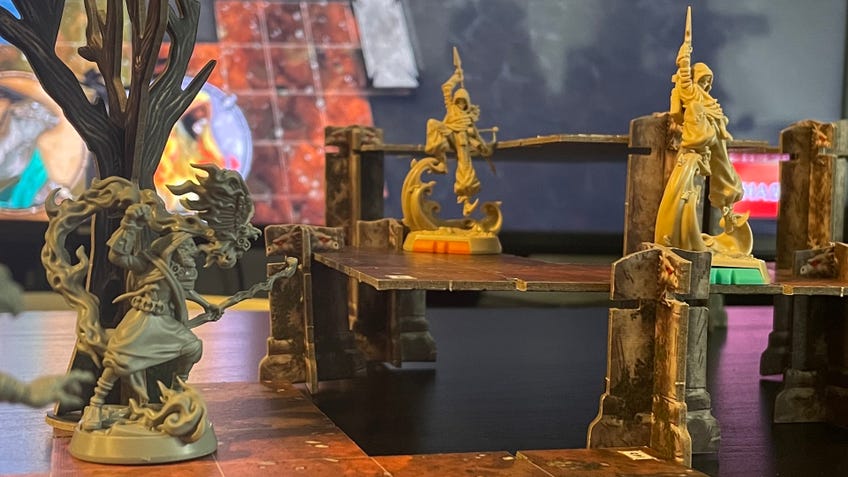
It’s especially frustrating, because when everything in Descent: Legends of the Dark comes together as planned - the 3D terrain, miniatures, companion app, storytelling, characters, scenario design, gameplay - it easily ranks as among the most impressive and entertaining fantasy board games in memory. It’s ambitious in its digital innovation, cinematic in its physical presentation, engaging in its combined delivery and, most importantly, huge fun to play with friends.
When everything in Legends of the Dark comes together, it ranks as among the most impressive and entertaining fantasy board games in memory.
At its best, it feels like board gaming’s answer to the Marvel Cinematic Universe - a big, flashy crowdpleaser that knows exactly how big, flashy and crowdpleasing it is. It may be refinement over revolution of one of the hobby’s most tried-and-tested formulas - fantasy adventurers crawling through a dungeon - but the refinement here is almost second to none.

That said, this is still a box that costs almost twice as much as most typical board games, and that’s hard to ignore - especially in the light of its flaws. Is buying Descent: Legends of the Dark better value than spending that same money on two - or more - board games that may not equal it separately, but each offer something not a million miles away, albeit with less visual flair and confident melding of ideas? Honestly, it’s a hard question to answer. If you’re not likely to commit to seeing everything the game has to offer, I’d recommend finding something else. But if you are willing to let it work its magic through thick and thin, I don’t think you’ll ultimately be disappointed with letting this replace your weekly D&D session for a few months.
All I do know is that, for all the frustrations I experienced, I’m still itching to fire up another campaign of Legends of the Dark and spend dozens more hours in that world, with those characters, that terrain and those scenarios. And when this game’s already announced sequel, Act II, arrives, you can bet I’ll be looking forward to returning to Terrinoth - something I never thought I’d say. Descent: Legends of the Dark may not be a perfect game, but it’s certainly one hell of a time.



